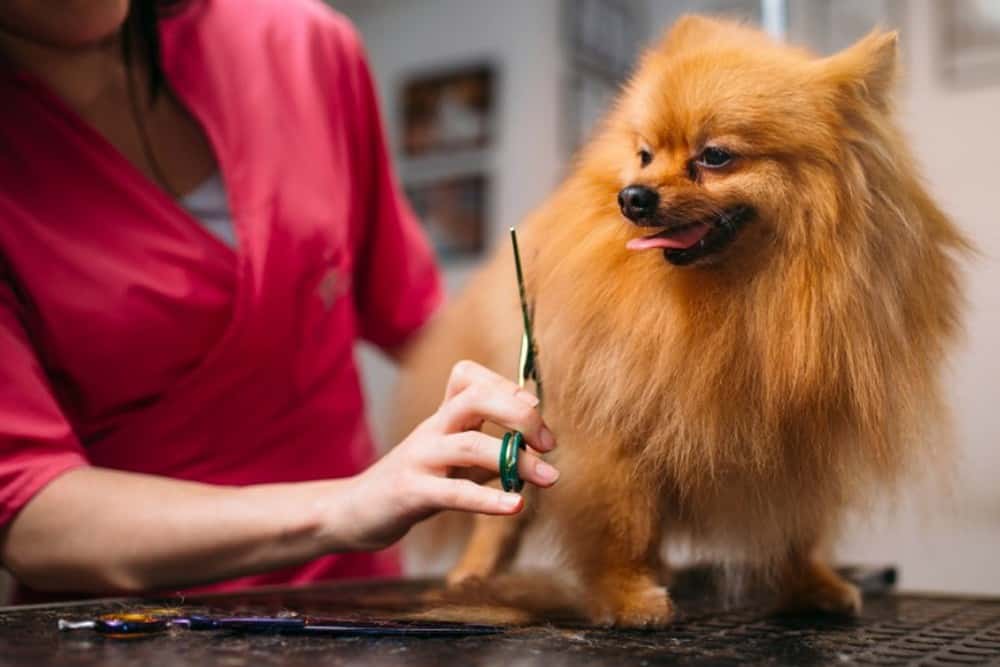When your Pomeranian sheds, you must brush his coat frequently to remove loose hair and make way for new growth. Use a slicker for shorter hair, a pin brush for areas of the coat more than a couple of inches long and a comb to check for mats. Otherwise, large amounts of dead undercoat can become trapped in the coat, leading to matting and skin problems.
Grooming tools that you’ll need include:
- clotting or styptic powder (for nails that bleed from being cut to close)
- comb — metal, long-toothed, medium/coarse (for legs, ears and face)
- curved scissors
- doggie toothbrush
- doggie toothpaste
- hair dryer
- nail clipper or nail grinder
- nail file
- pin brush without balls on the tips of the pins
- slicker brush
- spray bottle
- straight scissors
- thinning shears
- V-rake (to remove mats and tangles)
Routine Grooming
Some groomers don’t understand the Pomeranian coat or how to work with it. For one thing, a Pomeranian should never be shaved. That’s just a lazy way to deal with the coat. Groomers shave off the top coat leaving an inch or two of thick undercoat. That won’t help keep the dog cool or do anything to minimize matting or shedding.
The undercoat still needs to be stripped out to get the skin genuinely clean and allow it to breathe. Shaving can also cause hair loss in a Pom. Once you shave off the coat, there is no guarantee it’s going to grow back.
We suggest stripping out the undercoat with a V-rake if an owner wants to minimize grooming. It will simplify things because it removes about half of the coat, and less density means less shedding and matting.
Even if you remove the mats, weekly brushing is still necessary to remove dead hair and stimulate coat growth. Spray the coat with a light mist of water before brushing. Use a pin brush and brush out each section of the hair all the way to the skin.
Use a slicker brush for shorter areas. Use the pin brush for areas of the coat more than two inches in length. If you teach your dog to lie on his side during grooming, it will be much easier to work on hard-to-reach spots where mats are apt to form.
A pin brush may not get all the way through the coat. A use of a metal comb is recommended to get all the way to the skin and check for mats, which commonly form behind the ears.
If you find a mat, don’t pull it or cut it out. Instead, separate it as much as possible with your fingers. Gently work at it, alternately using one tooth of the comb and the corner of a slicker brush, until it unravels. This may take some time. Be careful not to cause any pain for your dog, or he will start objecting to the process long before you’re done.
Trimming The Coat
Every Pomeranian’s coat will benefit from a bit of trimming to even up stray hairs and neaten his outline. Groomers recommended trimming a small area around the anus for neatness and cleanliness. For a companion Pom, trimming is optional, but if you have a show dog, be prepared to devote substantial time to learning how to properly trim his coat.
Your goal is to trim stray, straggly hairs to create a neat, rounded silhouette. Exaggerated trimming or scissor marks in the coat are a dead giveaway that you don’t know what you are doing.
A correct coat helps a lot when you are preparing a Pomeranian for a show. You need to be a sculptor to properly trim your Pomeranian. Artful trimming leaves every hair coordinated.
Here’s a few basic tips:
- Always cut in the direction of the hair growth; never cut against the grain of the hair.
- Hold the scissors parallel to the skin and trim vertically, from the top down rather than horizontally. That can easily put scissor marks into the coat.
- Trimming requires a steady hand. Work slowly and stop to evaluate the results frequently. This is especially important when you are working with thinning shears; it’s easy to underestimate how much you are taking off.
- Brush and evaluate the results after every snip.
- Thinning shears with teeth on both blades are not recommended because they will remove twice as much coat with each snip.
- Thinning shears with widely spaced teeth produce more subtle results.

